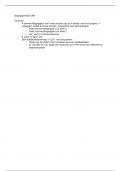Samenvatting
Summary of Judgment & Decision Making
- Instelling
- Universiteit Van Amsterdam (UvA)
A shorter summary than usual. This summary only includes the relevant points discussed during the lectures, such as specific tables of papers and the theory the lecturer discussed.
[Meer zien]













